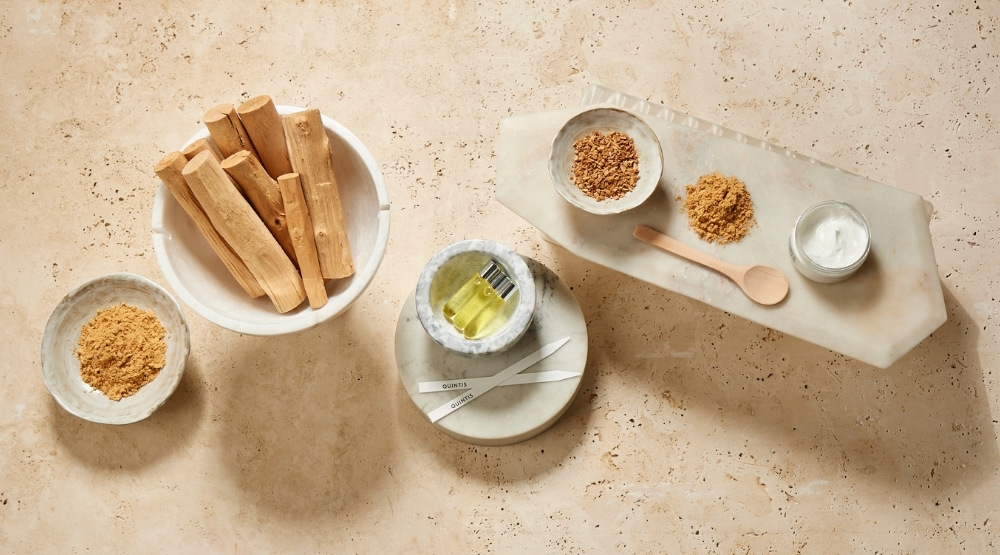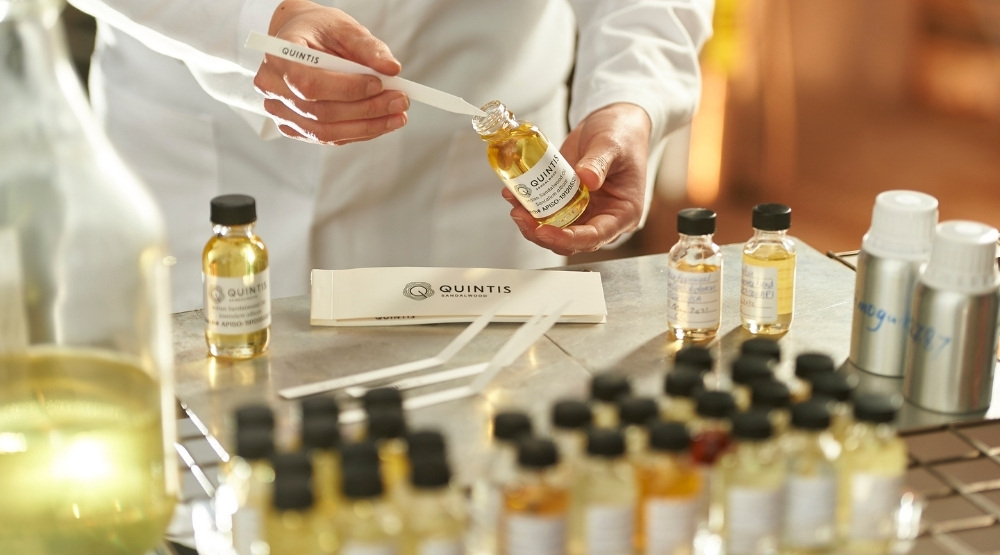Vitamin E (or tocopherol) has always been considered a one size fits all antioxidant in skincare. However, according to a new peer reviewed study commissioned by Quintis Sandalwood, it appears that Indian sandalwood oil is a more potent antioxidant than powerhouse vitamin E to protect skin against environmental stress. Sandalwood oil is a natural anti-inflammatory, a strong shield against free radicals and premature ageing and great at keeping skin soft and supple.
The study findings indicate that oil could serve as an effective protective and anti-ageing active ingredient in cosmetics and dermatology, opening up the potential to offer those benefits to consumers through a range of applications.
Professional Beauty chatted with Dr. Danny Hettiarachchi, Product Manager for Quintis Sandalwood, to find out a bit more about this skincare ingredient and why we might be seeing more of it in formulations to come. If you aren’t familiar with sandalwood oil – although many will recognise its strong aroma – it’s the essential oil extracted from the heartwood of a mature sandalwood tree that’s harvested by steam distillation, says Dr. Hettiarachchi.
Some of the notes that sandalwood oil carries can be described as hearty, grounding and complex. Dr. Hettiarachichi says “A complex chemical makeup in sandalwood oil provides a range of olfactory profiles: diffuse, woody, creamy, balsamic, and sweet. There are over 15 different sandalwood species found in the Indian subcontinent, the Indonesian archipelago, Australia, and Pacific region. Several species produce a highly aromatic wood that retains its fragrance for decades, with Indian and Australian Sandalwood considered the most important of these and Quintis produces high quality oil from both.”
While most people would associate it with fragrance or perfume (“In the last century, sandalwood oil has been widely used in the fragrance industry, with sandalwood notes found in nearly 50% of all modern perfumes created since 1790.”), sandalwood oil is one of the more stable active ingredients with incredible properties, says, Dr. Hettiarachchi. “Overall, sandalwood oil is a great natural multipurpose ingredient for cosmetics care as it is an effective protective and well-ageing active ingredient, and it has scientifically proven bioactivities with multiple benefits from its anti-inflammatory, antimicrobial, antioxidant and anti-tyrosinase properties.”
Why it’s not a popular skincare ingredient yet
The reason it hasn’t starred in the recent skincare boom could be down to overharvesting between 1980 and 2000. With trees needing decades to reach maturity, it’s only in the last decade that they would be ready ready for harvesting.
Quintis, in particular, has dedicated the past 20 years to producing and advocating for an ethical supply of Indian sandalwood to combat this ‘black market’ activity. Establishing the very first sustainable Indian sandalwood plantation in 1999, we now own and manage one of the largest Indian sandalwood estates in the world, spanning over 12,000 hectares across northern Australia and home to more than 5.5 million trees – a vast and reliable supply available for decades to come.
Its benefits
It offers multi-faceted benefits for the skin, says Dr. Hettiarachchi, thanks to active component alpha-santalol, which “targets a myriad of skin issues, including well-ageing, acne, and inflammation, with studies showing sandalwood is a natural anti-inflammatory, antimicrobial, and anti-pigmenting ingredient, along with being a powerful antioxidant. A peer reviewed study recently published in the Cosmetics Journal (commissioned by Quintis), found that Indian sandalwood oil is capable of significantly decreasing the damage to collagen in skin tissues caused by stressors such as blue light from solar and digital sources, and pollution from cigarette smoke.”
Researchers found that with subsequent exposure to environmental stressors, Indian sandalwood oil recorded a reactive oxygen species reduction 30-40% higher than the recorded reduction from Vitamin E.
Skin cells were also exposed to a source of solar blue light and digital blue light, and those cells produced reactive oxygen species, which begins a cascade of reactions detrimental to healthy skin. However, when the cell cultures were treated with sandalwood oil, production of reactive oxygen species reduced by up to 76%.
A multifaceted antioxidant
It is also worth noting that many botanical ingredients, especially essential oils, have a single benefit. Sandalwood is a multifaceted ingredient that can be used in a cosmetic or perfume product to achieve multiple benefits. Sandalwood oil is renowned for its aroma which can be a fragrance replacement, providing skin and psychological benefits upon inhalation and skin absorption.

What’s the best way to apply it?
Sandalwood oil is freely soluble in other oils making it ideal to combine with facial oils, creams and lotions for deep penetrating action. Water-based facial sprays, washes and hydrogels can be prepared by emulsifying sandalwood oil for its aroma and skin benefits. Sandalwood heartwood powder is suitable to blend in creams and powders to give an excellent skin feel and concealing effect, it is also suitable as a waterless ingredient in face masks.
Does it need to be used in certain concentrations?
The active concentration of sandalwood oil is 0.2-2% based on the level of benefits accepted, for multipurpose applications higher concentrations are required. As an example, a night repair product with sandalwood as the main active, which also provides destressing properties and a pleasant aroma, the highest concentration can be used.
Sandalwood has a high level of safety when it comes to toxicity and sensitivity. Sandalwood powder could be used in 1-20% in formulations, in products like face masks the highest concentration can be used.
What, if any, are the downsides to using it?
When using essential oils, like sandalwood oil, it is crucial to only use ones that are pure and professionally formulated to assist skin in the proper function of the benefits. Due to sandalwoods worldwide popularity, there are many low-quality synthetic versions of sandalwood oil for sale which can be harmful if applied to your skin and have no beneficial effects. When scoping out products with sandalwood be sure to check the labels and ensure the oil originated from Santalum album. If the label uses words like blended or scented try and avoid these as they could be low quality, synthetic versions.
Keeping in mind that consumers both want and need natural cosmetics and skincare options, Quintis’s trees are grown without hormones or artificial stimulants, ensuring 100% natural products, and each of our logs is assigned a unique identifier for full traceability back to each plantation. Our team, including foresters, agronomists, and chemists, nurture our trees through harvest and into production and are committed to producing sandalwood in a sustainable and natural way with a rigorous tree planting program, which we know is important for beauty, personal care, and wellness product makers.
Can it be used with other ingredients? Are there ingredients with which it should avoid being used?
Sandalwood is generally stable and compatible with many ingredients used in cosmetic and topical formulations. However, like with any other natural product, it is advisable not to use oxidizing agents such as bleaching products or metal ion-containing dyes or pigments.
Why is it suddenly showing up on the skincare scene?
Further to this, whilst research into the pharmacological effects of Indian sandalwood has been extensive in recent years, research into the cosmetic attributes of Indian sandalwood has not been as extensive until our recent study looking at the antioxidant and anti-aging potential of Indian sandalwood oil, which proves its efficacy for skin care applications.
We are looking to do more studies and research into the benefits of sandalwood as a cosmetics ingredient in its different forms, including oil, and powder to give evidence-based results, so sandalwood will continue to be considered for future cosmetic formulations.
What is its backstory? Does it have other uses?
Sandalwood is a tree deep-seated in culture and history, with Indian sandalwood heartwood one of the most valuable ancient cosmetic and medicinal ingredient, often described as the ‘wood of the gods.’
It was adopted across India, China, Arabia and Persia centuries ago for religious practices, what we now call ‘aromatherapy’, medicine, and cosmetics, such as Ayurvedic skin care – topical treatments based on principles of a 5000-year-old Indian health system – with sandalwood listed in the Charaka Samhita, an Ayurvedic Sanskrit text, over 2,000 years ago.
Many may not know that illegal poaching and harvesting of Indian sandalwood in India pushed supply to the brink in the 1980s, and this landed Indian sandalwood on the International Union for Conservation of Nature’s (IUCN) vulnerable species list in 1998. Illegal harvesting still continues, however there are now ethical suppliers of Indian sandalwood.
You can find out more about Quintis here if you’re interested in incorporating Indian Sandalwood into your product formulation.
—
Read the current issue of our digital magazine here:
- For more news and updates, subscribe to our weekly newsletter
- Follow us on Instagram
- Like us on Facebook
- Join Australia’s largest network of beauty industry professionals on LinkedIn
- Subscribe to our print magazine
Have an idea for a story or want to see a topic covered on our site and in our pages? Get in touch at info@professionalbeauty.com.au.

